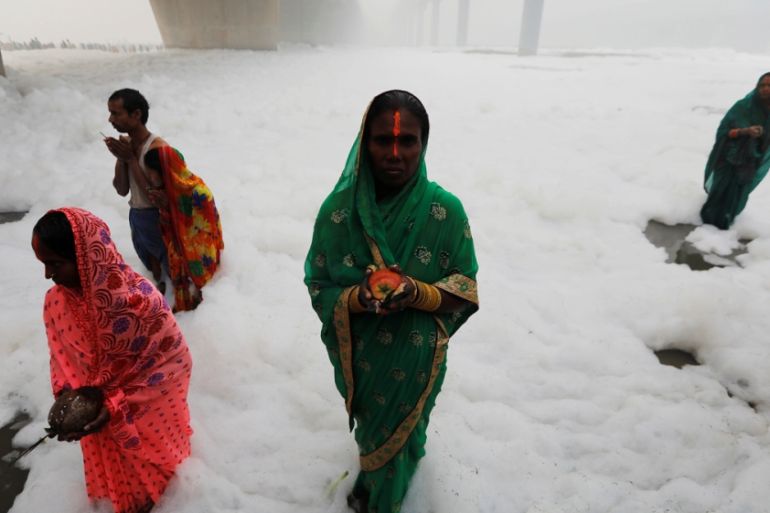‘Delhi in ICU’: Spike in respiratory diseases due to toxic smog
Severe pollution has been choking India’s capital, prompting the government to declare a public health emergency.

New Delhi, India – A blanket of toxic smog engulfed India’s capital this week, with air quality crossing dangerous levels and causing a public outcry.
A slight improvement was recorded in Delhi’s air on Monday when the government rolled out an odd-even numberplate scheme to limit traffic, putting almost 1.5 million private vehicles off the city’s roads.
Keep reading
list of 3 itemsAs debt grows, more Indian women farmers taking their lives
Indian activists, lawyers accuse government of spying on them
On Tuesday, the city’s air quality index (AQI) of 411 was still in the “severe” category. The safe limit specified by the World Health Organization is 60.
More than 40 million people living in and around Delhi have suffered from the poisonous air as politicians indulged in a blame game and, in some instances, offered bizarre solutions.
As the city wheezed, India’s environment minister advised people to “start your day with music” in a tweet, while the health minister recommended “eating carrots” to help in combating pollution-related health issues.
Delhi’s Chief Minister Arvind Kejriwal, who called Delhi a “gas chamber”, declared a public health emergency.
“For the last few years, the pollution levels have drastically increased in Delhi’s air. It’s the biggest health issue,” said Puja, 40, a resident. “But nobody is doing anything through the year and they wake up when the pollution levels reach [a] hazardous level.”
Most-polluted cities
Delhi has a year-round pollution problem with residents yearning for days when they can breathe clean air. It is among 14 Indian cities listed in the World Health Organization’s top 15 most-polluted cities globally.
Vehicles and industrial activities are major contributors to air pollution along with rampant construction.

But every year around October-November, the air quality becomes hazardous due to pasture burning in the neighbouring states of Punjab and Haryana.
India’s Supreme Court on Monday lashed out at both Prime Minister Narendra Modi’s central government and the Delhi government, saying they were not doing enough to curb pollution levels and passing the buck to each other.
“Delhi is choking every year and we are unable to do anything. This can’t be done in a civilised society,” the court said.
The top court called on the city authorities, as well as neighbouring state governments, to work out a solution to this recurring problem.
Impact on health
Pollution levels of this scale are linked to chronic bronchitis, lung cancer and heart disease, health practitioners say.
The air quality in Delhi has been particularly bad since October 28, a day after the Hindu festival of Diwali, and doctors say they have recorded a 20 to 30 percent spike in the number of patients with respiratory diseases.
Doctors say that they have seen symptoms worsening in patients with asthma and chronic obstructive pulmonary disease (COPD).
“The air pollution is a very big health concern. The trends are worrying,” said Dr Karan Madan, a pulmonologist at the All India Institute of Medical Sciences (AIIMS), New Delhi.
“The effects [of a crisis] are sometimes not very immediately apparent. The immediate apparent effects of cough, itching in the eyes, sore throats, might be just a tip of an iceberg.
“But what is happening with all the pollutants that one is inhaling in such a large quantity over such a long time, their health effects in the long term will be very significant,” Dr Madan told Al Jazeera.
A study released in June by the Centre for Science and Environment, a Delhi-based advocacy group, says poisonous air kills more than 100,000 children under five every year in India.
The life expectancy of people living in the Indo-Gangetic Plain has dropped by up to seven years due to poor air quality, according to a study by the Energy Policy Institute at the University of Chicago, released last week.
Measures taken
The crisis has prompted the government to declare a public health emergency, shutting down schools and banning construction work.
Earlier, Kejriwal, the Delhi chief minister, announced the distribution of about five million face masks to schoolchildren as the city reeled under the worst pollution crisis in years.
On Monday, a third edition of the traffic-cutting scheme, under which cars with odd and even numberplates can drive on Delhi’s roads only on alternate days, was also rolled out.

But analysts say that it is not enough.
“Delhi is in an ICU (Intensive Care Unit) right now,” said Ruchika Sethi Takkar, founder of Citizens For Clean Air, a citizens’ collective.
“There should be zero tolerance towards any violations contributing to direct triggers of air pollution,” she told Al Jazeera.
Pallavi Pant, an air quality scientist based in Boston, told Al Jazeera that air pollution was a multi-sectoral problem and is a serious environmental concern across India, not just in Delhi.
“At the national and regional level, we need to address sources such as solid fuel use in households and power plants, whereas at the local level, we need to focus on sources such as transportation and waste burning,” she said.
Pant further said that a discussion on Delhi’s air quality was incomplete without the broader discussion on air pollution in the Indo-Gangetic Plain.
“Air doesn’t respect geographic or political borders, and in order to improve air quality in the Delhi region, we need a strategy that address both local sources and regional sources and that includes government actors from various departments and states,” she added.